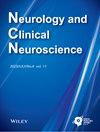Case of anti‐NT5c1A antibody‐seropositive inclusion body myositis associated with severe dysphagia and prominent forearm weakness
IF 0.4
Q4 CLINICAL NEUROLOGY
引用次数: 0
Abstract
We report a case of an 82‐year‐old woman with inclusion body myositis (IBM), who presented with severe dysphagia, finger flexor weakness, and respiratory dysfunction. In addition, the patient showed prominent forearm weakness with quadriceps sparing and was seropositive for the anti‐cytosolic 5′‐nucleotidase 1A (NT5c1A) antibody. The presence of the anti‐NT5c1A antibody is presumably associated with dysphagia. We speculate that the anti‐NT5c1A antibody is associated with the large discrepancy between distal upper limb weakness and proximal lower limb weakness in IBM.1例抗NT5c1A抗体血清阳性包涵体肌炎伴严重吞咽困难和明显前臂无力
我们报告一例82岁女性包涵体肌炎(IBM),表现为严重的吞咽困难,手指屈肌无力和呼吸功能障碍。此外,患者表现出明显的前臂无力,股四头肌保留,抗胞浆5′核苷酸酶1A (NT5c1A)抗体血清阳性。抗NT5c1A抗体的存在可能与吞咽困难有关。我们推测,抗NT5c1A抗体与IBM患者远端上肢无力和近端下肢无力之间的巨大差异有关。
本文章由计算机程序翻译,如有差异,请以英文原文为准。
求助全文
约1分钟内获得全文
求助全文

 求助内容:
求助内容: 应助结果提醒方式:
应助结果提醒方式:


